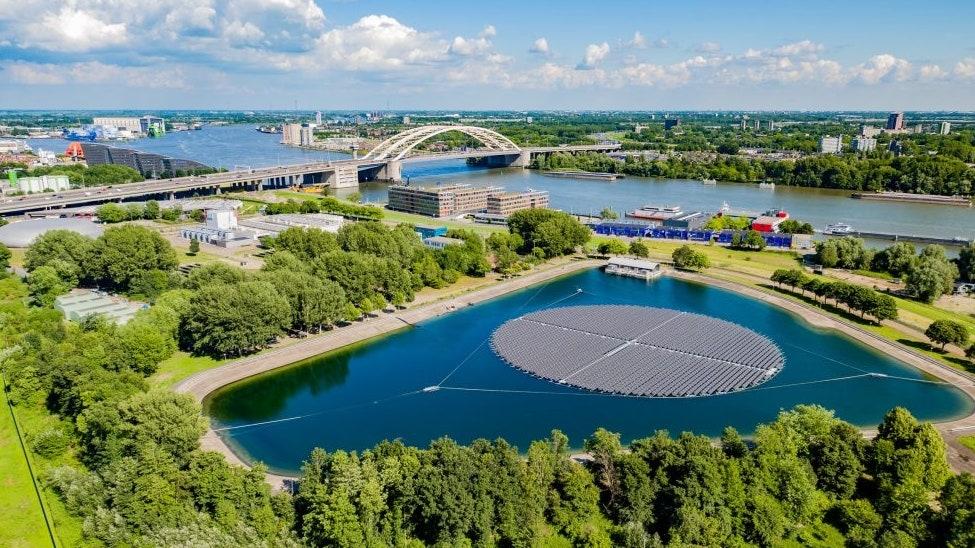The Dutch have always been inspired by the water—no surprise, considering the country borders the North Sea and its interior is speckled with an abundance of lakes, ponds, and waterways. Land is scarce in the Netherlands. And much of the terrain, including Rotterdam, the second largest city, sits below sea level. This fact has spurred a concerted eco-consciousness and inventive use of water for technological developments, including generating electricity. Enter Floating Solar, a Dutch company that creates innovative renewable solar systems, including Europe’s largest floating, sun-tracking solar park that’s just four miles from central Rotterdam. (In several months, they’ll have three even bigger ones generating electricity in the Netherlands.) Collaborating with Floating Solar, Evides Waterbedrijf, a company that supplies drinking water to more than two million consumers and companies in the Netherlands, is home to this unconventional assembly.
“We see it as our social responsibility to contribute to our national sustainability goals and to the Dutch energy transition,” says Dirk Mathijssen, program manager. Almost 3,000 solar panels stretch across a circular platform that’s 345 feet in diameter (essentially an island) that floats in a seven-some-acre reservoir, where Evides stores river water before it’s treated to become drinking water. “By using this water surface, we ensure that the scarce land remains available for other purposes,” Mathijssen explains.
The solar park yield is 20 to 30% more energy than with static (land) systems, mainly due to the fact that it rotates with the sun while allowing the water beneath to cool the solar panels.
Unlike what we’re accustomed to with land-based solar panels that are mounted on a stationary surface, here, thanks to solar-sensors embedded in the platform and a series of anchor cables and winches, the entire rig rotates, allowing the solar panels to track the sun’s movement across the sky.
These floating, sun-tracking solar panels offer myriad advantages. According to Kees-Jan van der Geer, general manager at Floating Solar, “The energy yield is 20 to 30% higher than with static (land) systems.” That’s because this system is highly efficient, both due to the fact that it keeps its eye on the sun, so to speak, and also the water has a cooling effect on the solar panels. The result: this distinctive assemblage generates about 15% of the electricity that Evides consumes at this water processing site, a significant amount, to be sure. (Evides also employs a number of land-based solar panels, the entire set up producing an impressive two gigawatts of electricity, an amount that some 650 households might use, on average, in a year.)
“Be prepared” could be Floating Solar’s motto, given that they’ve taken into consideration a variety of problems that can befall floating solar panels. For example, Rotterdam can often see powerful winds gusting across the city. So, they’ve implemented sensors to monitor wind forces, the height of waves and many other variables, making the system stormproof, explains van der Geer. If the wind gusts at 47 to 53 m.p.h., “we turn the island square into the wind so it blows through the rows of solar panels.”
The solar panels have been designed to take nesting birds and potential harm from strong winds into account.
And then there are the birds that might think about alighting on the panels, leaving droppings, or building nests, situations that would reduce the system’s efficiency. That’s why the solar panels are set at an angle that’s not conducive to bird visits.
The future, for Evides, seems quite green—a commitment to environmental consciousness that is understandable, given the need to protect and preserve its water sources. With the floating and land-based solar panels, “we are aiming to be energy neutral by somewhere between 2025 and 2030,” says Mathijssen.









